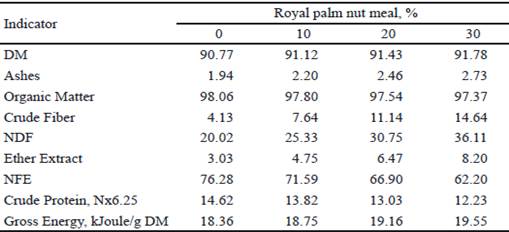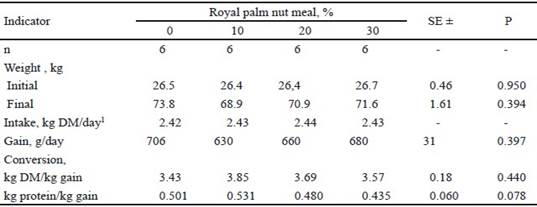Royal palm nut is the fruit of the Cuban royal palm tree (Roystonea regia H.B.K. Cook). Royal palm tree is one of the most numerous trees in Cuba, with an approximate existence between 12 and 15 million. With a mean production of 40-60 kg/palm/year, an average production of around 600 thousand tons of palm nuts per year is calculated (Valdivié and Bicudo, 2011).
Palm nuts are one of the main energy alternative feed available in Cuba due to their high content of fat or oil, which has the double of digestible energy of fiber (Arias et al. 2016). Therefore, although fiber fraction of palm nuts showed a low digestive use due to its polymeric nature with β-glycosidic links (Bach Knudsen 2011), this is compensated by lipid digestibility, which is practically complete (Ayala and Ly 2017 and Ly et al. 2017).
At the Institute of Animal Science, Díaz et al. (1989) recommended the inclusion of royal palm nuts in the diets of growing pigs in a proportion of up to 40 %, for fattening animals at a level of 60 % and for pregnant sows at a level of 30 % in unconventional low energy density diets, mainly manufactured with food waste (half-cooked food) and sugar cane molasses. In studies conducted by Abeledo et al. (2004) and Díaz et al. (2010), royal palm nuts have been used in swine feeding, although certain factors such as genotype or particle size could have a negative influence on the data obtained in these circumstances (Ly et al. 2015).
The objective of this experiment was to determine performance traits in growing pigs fed diets partially replaced by royal palm nut meal.
Materials and Methods
Experimental design and animals. A completely randomized design with 2x4 factorial arrangement was used to study performance traits in 24 commercial crossbred pigs (Yorkshire x Landrace x Duroc), females and castrated males in the same proportion and with an initial mean weight of 26 kg. The animals belonged to the herd of the Institute of Animal Science. These pigs were randomly distributed in four treatments consisting of diets with 0, 10, 20 and 30 % of royal palm nut meal, on a dry basis (Table 1). The factors were sex and the level of royal palm nut meal in the food.
Table 1 Chemical composition of royal palm nut

1In natura
2Calculate according to Nehring and Haenlein (1973)
Table 2 Composition of experimental diets (percentage under dry basis)

1Vitamins and trace elements according to NRC (2012)
Preparation of the royal palm nut oil. The royal palm nut, with around 30 % of in natura DM was obtained in the El Uvero farm, belonging to the enterprise Flora y Fauna, in Jaruco municipality, Mayabeque province. Drying process of royal palm nut consisted of manually removing the palm nuts. Later, they were exposed to the sun by spreading the seeds in a drying plate, for 5 consecutive days, from 8:00 am to 4:30 p.m., picking up the material in bags before nightfall to avoid the increase of humidity due to the night dew.
Dry material was stored in bags, under roof, in buildings with adequate ventilation and low humidity level. It was ground together with the rest of the components of the diet of grains and cereals in the corresponding proportion every 5 days. This way, it was allowed to extend the useful life of the royal palm nut meal because it is known (Ly et al. 2005, Santana, 2006, Díaz et al. 2010, Valdivié and Castro (2010) and Caro et al. 2014) that royal palm nut rapidly becomes rancid, decreasing its biological quality and palatability by animals. In addition, grinding the nuts, rich in fat, was facilitated without clogging the mill. A representative sample of the lot was taken, to know its physical and chemical characteristics. Table 1 shows the characteristics of the chemical composition of the palm nuts that were used in the test.
Diet preparation. Diets were produced with grains and formulated to contain variable levels (0, 10, 20 and 30 % on dry basis) of royal palm nut meal. Table 2 shows the characteristics of diets.
Table 3 shows the nutrient content of experimental diets. As expected, as more royal palm nut meal was included in the feed, fiber percentage and fat in the diet increased, and crude protein content decreased. As a result, the energy: protein ratio was also modified. No fits were made to establish isoproteic or isoenergetic diets.
Animals and management. All individuals included in the test were apparently healthy, without clinical symptoms of any disease, and conveniently dewormed. Animals were housed in individual pens with cement floors and steel frames, in an open stable. Each of these pens was provided with a feeding trough and drinking trough.
Pigs were randomly distributed in the four treatments, with six repetitions each and a 2x4 factorial arrangement, consisting of four diets supplied according to the recommended daily intake scale in Cuba in conventional feeding intensive systems during growth, according to the Porcine Breeding Manual of the Instituto de Investigaciones Porcinas (IIP 2008). Table 4 shows the feeding scale used. Drinking water was always available. Animals were weighed at the beginning of the experiment and every fifteen days in order to know the evolution of body weight gain curve. The experiment concluded when animals reached around 70 kg of weight, about 65 days after having begun, as an approximate average.
Chemical analysis. Most of the nutrients, except NDF, that were measured according to Van Soest et al. (1991), were determined by duplicate in representative samples, regarding known procedures (AOAC 2005). As it is established (Arias et al. 2016), concentration of organic matter was obtained from subtracting ash percentage from 100, nitrogen-free extract (NFE) was the consequence of subtracting concentrations of ash, crude fiber, ether extract and crude protein (Nx6.25) from 100, while the heat content was estimated from the chemical composition of royal palm nut through the use of Nehring and Haenlein (1973) equation, as in the other cases (Arias et al. 2016; Ly et al. 2017). All chemical determinations were carried out by duplicate.
Statistical analysis. Data were processed according to a completely randomized design with 2x4 factorial arrangement, in which factors were sex and diet (Steel et al. 1997), and the statistical package InfoStat (Balzarini et al. 2001) was used for their manage-ment.
Results
During the test, no animal showed any symptom of discomfort that could indicate any disorder apart from the performance test.
No differences were found (P>0.05) in the interaction sex x diet in any measure. Table 5 shows data of performance test regarding sex.
Final weight of castrated males showed no differences (P>0.10). In addition, there was no effect of sex on daily mean gain nor on food conversion, of DM and protein.
Table 6 shows the effect of including variable levels of royal palm nut meal in the diets. There was no significant effect (P>0.05) on final weight nor on daily gain with the increase of royal palm nut in the food. In the case of protein conversion, there was no statistical difference among treatments but, from a biological point of view, there was a tendency (P<0.078) to be lower with the increase of royal palm nut meal in the diet for pigs.
Table 5 Performance traits of pigs fed royal palm nut meal. Effect of sex

1Intake at scale. For details, see full text
Discussion
Data related to nutrient content of royal palm nuts used in this research showed similar characteristics to those of the representative samples from the western part of the country or from other places in Cuba (Ly et al. 2005, Caro et al. 2015 and Arias et al. 2016). Therefore, it was considered that the experimental results were representative of royal palm nuts existing in Cuba, or at least from the western part.
Except data of Batista (2015), who studied feeding of castrated male and female pigs in groups with royal palm nut meal, there were no antecedents of this research belonging to the effect of sex on pigs fed royal palm nuts (Ly et al. 2015). Results found in the present study with animals individually housed, are in accordance with the generally accepted fact that castrated male pigs show better performance traits that females (Tribble 1991). About this matter, Batista (2015) also found better performance traits in castrated males regarding females. This information may be valuable for the design of feeding systems of developing female pigs for being used as reproducers fed with royal palm nut meal, from which there are no references either (Wahlstrom 1991).
The inclusion of royal palm nut meal for replacing from 0 up to 30 % of the diet was due to the well-known fact that pig fattening by agreement, the pig state enterprise provides 70 % of food needs and pig farmers supply the remaining 30 % (Batista 2015 and Arias 2016). In the substitution range designed in the present experiment, it could be logical to expect that an increase of royal palm nut meal in the food should have negative consequences in the performance traits due to the growing inclusion of fiber fraction in the food (Wenk 2001, Bach Knudsen 2011, Kerr and Shurson 2013, Lindberg 2014 and Jha and Berrocoso 2015). Such thing did not happen and there could be many causes for these results. First of all, royal palm nut meal was obtained here when grinding this food resource with the rest of ingredients of the diet formula, which assured a very efficient grinding of food, with an evident reduction of particle size. It is well known that a decrease of particle size contributes to a better digestive use of food (Kim et al. 2005 and Ly 2008). Consequently, it determines better performance traits (Mavromichalis et al. 2000; Ngoc et al. 2011). On the other hand, rectal digestibility indexes found with the same diets in another parallel experiment (Oliva et al. 2017), are in agreement with this hypothesis.
It should also be considered the important contribution of lipid substances within royal palm nuts to the diet, and that they have demonstrated a high digestive use (Ayala and Ly 2017). This way, even though fiber fraction of royal palm nuts determines a decrease of the energy density of diet, ether extract, mainly constituted by medium chain fatty acids or long chain unsaturated acids, usually shows a very efficient digestive use (Ly 2008), and, without doubts, this tends to counteract this negative effect of fiber fraction. The high contribution of fats to increase energy density of food is well-known (Nehring and Haenlein 1973).
Another cause could be that guaranteeing a constant and homogeneous feeding, such as the one carried out in this research, could contribute the good results. In previous experiments, together with the supply of royal palm nuts without grinding to the animals, mixing it with sugar cane molasses, could contribute to worsening performance traits of economic interest, like those reported in other researches (García et al. 2001 and Abeledo et al. 2004).
Finally, the use a feeding at scale like the one suggested under Cuban conditions of commercial fattening (IIP 2008) could contribute to an improvement of performance traits because it is also very well-known that, under ad libitum feeding conditions, food conversion has a remarkable deterioration (Tribble 1991 and Patience et al. 2015). This subject requires more research.
It is advisable to feed growing pigs with diets that contain up to 30 % of royal palm nut meal. It is suggested to conduct performance traits in other categories, like reproducer sows.











 text in
text in 





